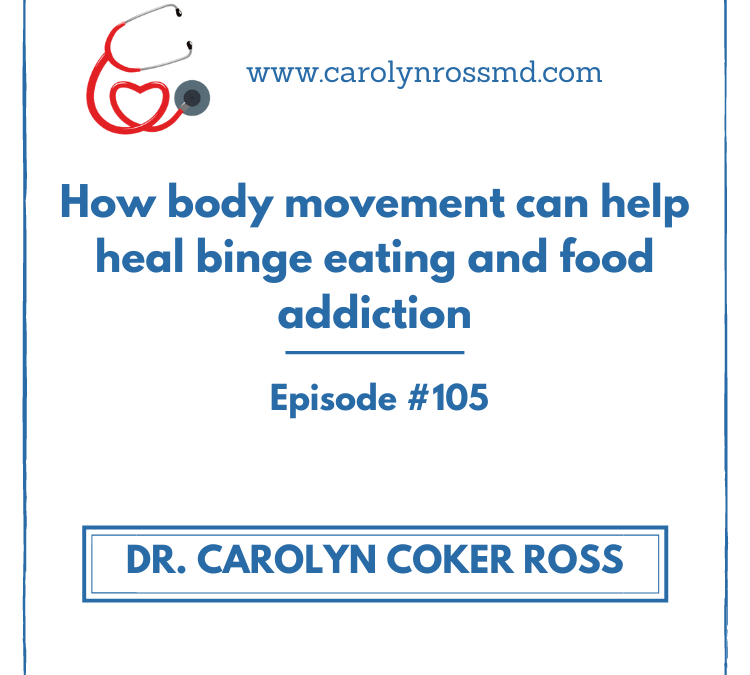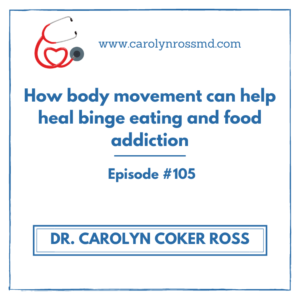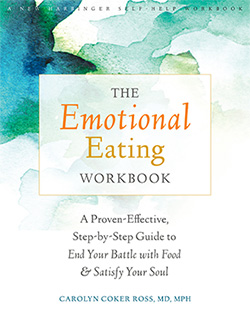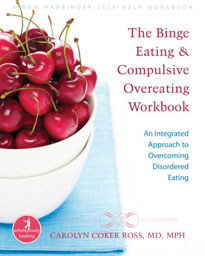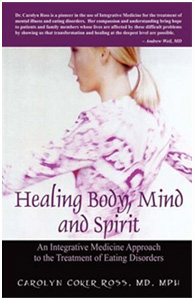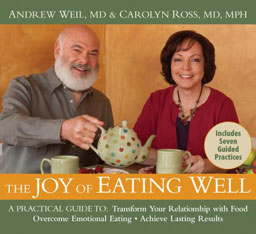Physical activity has been co-opted by the diet industry just as food has – in other words, only good to get you to lose weight. No wonder thinking about body movement may send you into a fit of resistance or rebellion or make you feel guilty – feeling you’re not doing enough or not doing the right kind of activity that the experts say you should. If you struggle with binge eating, food addiction or emotional eating, you may struggle in finding a way to move your body that doesn’t feel like something you have to do or something you feel bad about not doing.
In this podcast, you will learn:
1. How to recognize if you’ve experienced exercise trauma.
2. How to reclaim body movement as a form of self-expression.
3. What the 3 most common reasons for not being physically active are and how to address them.
Schedule a free consult to discuss your food and body image issues: https://findingyouranchor.as.me/consult
Get a free copy of my book (only for shipping in US): “The Food Addiction Recovery Workbook” (I pay for the book, you pay for postage) – https://www.foodaddictionrecoveryworkbook.com/free?utm_source=crpodcast
If you’re interested in getting the FREE e-book or you are an international listener, (you pay for handling charge only), use this link to get your free e-book of “The Food Addiction Recovery Workbook.” https://www.foodaddictionrecoveryworkbook.com/ebook
Welcome everyone. This is episode number 105 How body movement can help heal binge eating and food addiction. Stay tuned.
Hi everybody Dr. Carolyn here today, I’m going to be talking to you about how body movement can help heal binge eating and food addiction. So let’s get started. First of all, I just want reference how hard it is for most of us to move our bodies without thinking about it as being part of the diet regimen. So either we’re punishing ourselves with exercise because we’ve eaten too much or we’re exercising like crazy because we’re on the latest fad diet.
So I want to just start by talking a little bit about one of my former patients. Carol was a bubbly 30 year old woman from a large Italian family. As a child, Carol loves to play soccer, but at age 11, at the end of soccer season, her coach took her side and told her that she was not going to be able to be part of the team next year because of her size. She was crushed and surprised because she really considered herself to be an athlete. She loves soccer. She also rode her bike everywhere and enjoyed most athletic activities. But when she had joined the anchor program, she did well in all aspects of the program, but seemed unable to really get started on a body movement program. When asked about negative experiences around your exercise, she remembered what happened when she was 11 years old and the coach told her she couldn’t play soccer.
After that conversation, she had begun to believe that she could not be athletic because of her size. And so she just stopped being active at all. But after working through some of the feelings from this traumatic experience, Carol was able to start just opening the door to being more physically active again, something that she found she still love. So, as I said, physical activity has been co-opted by the diet industry, just as food has. In other words used only in the service of trying to get your weight down. No wonder, just thinking about exercise can send people into a fit of resistance and make you feel guilty. Either because you think you’re not doing enough exercise or you’re not doing the right kind of exercise that the experts “have told you will help you lose weight”. So just as I encourage all of the people that I work with to question the conventional wisdom about food that say or weight, that says you have to be thin to be healthy or that some foods are bad foods and you should only eat “good foods” or only eat clean, as we talked about recently in the food freedom challenge, I’m encouraging you now to turn your inner skeptic towards the field of exercise or physical activity and all its attendant expert advice. You see I’m using a lot of air quotes today. Now you may be lucky enough that you already enjoy as exercise and you see it as a normal part of your day to day life to you I say. Keep up the good work. But if you have food and body image issues, you may struggle with physical activity to you I say, don’t throw out the baby with the bath water. And what I mean by that is don’t let the voices of your former coaches or parents or the family members or acquaintances or people you meet in the street or anyone else who robbed you of the joy of being in motion. Don’t let them take away the pleasure inherent in moving your body. Don’t let the voices of experts again in air quotes, who told you that you’ll only lose weight by doing certain exercises, stay in your head, kick out of your mind. Anyone who told you as Carol was told that you couldn’t do a sport or an activity because of your size.
Just as you can learn to eat with joy, you can reclaim your right to move your body with joy. Just think about little children if you have any little children or if you are an auntie to some small children moving your body is natural when you’re a child. For example, babies are in motion all the time, kicking their legs up, touching their feet with their hands, rolling over, standing up. Toddler start to stand up eventually they let go of the coffee table or the couch, and then they try to walk and run as soon as they are able. And every time they fall, they get up again. Why? Because this desire to move your body is hardwired in our genes. And of course moving your body’s good for you. When we talk about health at every size, just being in motion, just having some form of physical activity, not that you have to do, but that you enjoy doing contributes to your overall health and wellbeing. But the bottom line is there’s only one should hat you need to pay attention to and that is to find an activity that you love to do, that you enjoy doing, not forcing yourself to do something because you think it’s the best way to lose weight or it’s something that someone told you you should be doing.
So, find a starting point where you can find something you love and just stay open and curious, try new things. You know, when I was in my late forties, I think my youngest son convinced me to try Taekwondo. I never ever thought I would like a martial arts, but I ended up loving it. And I think I’ve mentioned in previous podcasts, humble, bragging that I got a black belt in Taekwondo. So I won’t go over that again. But if I hadn’t been curious and given it a try, I never would’ve learned how much I enjoyed it. Now, there are a lot of people who say I can’t exercise because, and there’s fill in the blank.
So I want to go through some of those resistance that people give for not being active. One is I feel embarrassed by my size and I don’t want to exercise in public. Well, this is a very valid concern and one that you can address in multiple ways. For example, take a friend with you to a class or do a one-on-one class to get yourself started so that you can feel more comfortable doing the activity.
The second reason that’s often given you, I have health problems and every time I exercise, I have pain or injuries or other symptoms. Now this can be a real problem, especially as we get older. But if your motivation is strong and you are experiencing some unpleasant symptoms, I would recommend that you seek the help of a physical therapist or a personal trainer who’s used to working with people with some body limitations.
Another reason that’s given is I just get bored so easily. And yeah, I’ve said that myself and I have to say for example, I, I was found running boring, even though I have a son who has to run marathons multiple times and I just couldn’t figure out, like, what is it about marathons that you find interesting. But however, as time goes on, I, again, stay curious. And during the pandemic, when I wasn’t able to go to the gym, I ended up buying a treadmill. And low and behold, I figured out a way to pair doing something I wanted to do with something I kind of wanted to do. Like, I kind of wanted to be on the tread now, but what I did was I took my iPad out to the treadmill and I watched Netflix shows while I was walking on the treadmill. So that kept me from getting bored. So if you’re finding yourself bored, pair your exercise with something that you really want to do.
The final reason given is I don’t have time. Well, in my experience, time is really never the issue. Just think about all the things you fit into your day and you have to ask yourself, what priority do you give physical activity? And could you move it higher up the list of priority so that you can maybe schedule some time for even just a 10 minute walk at lunchtime? There are also a lot of emotional blocks to exercise. If you’re still not feeling motivated to exercise or to be active you’re right to, you know, you may be like Carol, and then you’ve had some exercise related trauma or embarrassment or some experiences in the past that have turned you off of exercise.
Now, in Carol’s case, she never really linked what happened with her coach or soccer coach at age 11, with her dislike of exercises as adult. But as I said, moving your body is natural part of what it means to be human. When you feel resistance to something that is natural, like body movement, you might want to ask yourself when that started. When did you start, you know, rebelling against moving your body? When was the first time that that happened, and that may lead you to be able to discover some exercise related trauma that you haven’t maybe thought about in a long, long time? Another thing to think about is that moving your body in a mindful way, particularly if it involves conscious breathing like Tai Chi or yoga, or chigong will enable you to be less uncomfortable in your body, it can actually help you connect to your body. And there are even yoga classes for people who’ve had trauma, it’s called comment form yoga classes that can help you heal from trauma through the practice of yoga.
I hope you’ll remember that moving your body is not something you have to do. So don’t go all Marine drill Sergeant on me. Just think about, think about something you would love to do and tap into that inner feeling that draws you to a form of moving your body. It may not make sense to you just as being interested in TaeKwonDo didn’t make sense to me. But your body knows what it wants better than you do for sure. Better than our intellect our mind does. And this is another way to tap into body wisdom, which we talked about in the five steps to recovery. Follow your feeling, stay open and stay curious. Remember, this is your body and how you move is your decision.
So I have a couple of homework questions for you that might help people a little deeper with focusing on body movement and how it can help you heal for binge eating and food addiction. So the first question I advise that you journal about these, the first question is, see if you can imagine the feeling of being in movement when you were a child and describe that feeling. For example, I felt so free when I was running through the grass in my bare feet.
The second question is, ask yourself what made moving your body feel the way you described as a child? For example, it just felt so freeing to do what I was doing. No one had to tell me I was doing it right or wrong. I was happy because I was doing what I wanted and loved to do.
And then finally, question number three, list three things you can do to reclaim your body’s desire to move. And if you’re ready and willing the act of actually doing or trying some physical activity will help you begin to heal emotional blocks to move your body.
I hope this has been helpful and I want to just remind you to share this with anyone who you think might benefit from it. Also give us a rating and help us share this message. I want to remind you also that the free book offer is still going on for a little longer, you can get it. If you’re living in the United States, you can get a hard copy of the food addiction addition recovery workbook. If you live overseas, you can get the ebook of the food ddiction recovery workbook. And there is a shipping charge for the hard copy and there’s a handling charge for the e-book, but I will pay for the book you pay for the shipping or handling.
And don’t forget the anchor program is in full force. We have a new program starting very soon, and if you’re interested, schedule a free consult to discuss your own individual food and body images.
Okay, this is Dr. Carolyn signing off. See you next time. And we have a couple of interesting topics coming up. The next one will be how to repair and heal your relationship with your body. And then I also have an interview with registered dietician and expert in internal family systems that is coming up. So look for both of those, and I will talk to you soon.
I hope this podcast has been helpful. And number one, helping you identify if you’ve had any exercise trauma from childhood or adolescence or whenever, and number two in helping you understand that body movement is a normal hardwired part of our DNA and that number three most important thing is to find something you love to do, whether it’s conventional “exercise” or whether it’s something completely different, it should just be a way for you to move your body in a way that makes you feel joy.
So I wanted to also just offer a couple of homework suggestions for you, ways that you can kind of work on this. So, first of all, to help you tap into that component of physical activities being so natural, the first homework assignment. Number one is see if you can imagine the feeling of being in movement when you were a child and then describe or journal about that feeling. So for example, you might say, I felt so free when I was running through the grass in my bare feet, or when I would go swimming with my dad and he would throw me off his shoulders, into the pool. I remember laughing so hard. I was hiccuping when I would ride my bike down a hill going as fast as I could on a dare from my brother. I felt excited and careful. So see if you can, again, imagine the feeling of being in movement when you were a child and describe and journal about that feeling. Number two, now, ask yourself what made moving your body feel the way you described as a child. So for example, you might write, I felt free because it felt so natural to be doing what I was doing. No one had to tell me I was doing it right or wrong. I was happy because I was doing what I wanted and loved to do. So number two is ask yourself what made moving your body feel the way you described as a child. And number three, finally, list three things you can do to reclaim your desire to move your body.
If you’re ready and willing the act of actually doing something physical will help you heal emotional blocks to moving your body. And you might want to put a timeline on there, you know, steps that you need to take any specialist, any support you may need to help you complete it. So for example, you can put, I will take one ballroom dancing class within the next three months, and I’m going to ask my best friend, if she’ll take the class with me.
Now, if you feel you’re not ready to explore body movement of any kind list below any actions you can take to help you become more ready. For example, I will continue to work on my trauma with my therapist until I feel more comfortable with the idea of moving my body. So I hope these journaling assignments, this homework will be helpful for you to start reconnecting with your body and finding some joy in physical movement.
Please do me a big favor and give this podcast a rating, help get the word out. Also share it with anybody who you think might benefit from it. And I just want to remind you of two things. One is that we still have the free book offer available so you can get the hard copy of my book, the food addiction, recovery work. I paid for the book you pay for the postage. Now this only applies to US mailing within the United States, just because international mailing is prohibitive. So if you’re international, if you’re outside of the United States, you can get a free copy of my ebook. Again, I paid for the book you pay a small handling fee and those links will be in the show notes. So if you’re international, go for the free ebook, if you’re in the United States and you want the hard copy, then feel free to hit that link. And if you’re in the United States and you want the ebook anyway, you can also do that. So I hope you’ll take advantage of this because it won’t last forever. I’m going to tell you that. Can’t afford to keep giving, well, all these free books.
All right, well, I’d look forward to seeing you next time. And on the next podcast, we’ll be talking about something really good. So let me tell you what that is. That will be episode number 106. How to reconnect with your body to heal binge eating and food addiction. Hope you’ll join us then this is Dr. Carolyn signing off. Thanks for listening.

